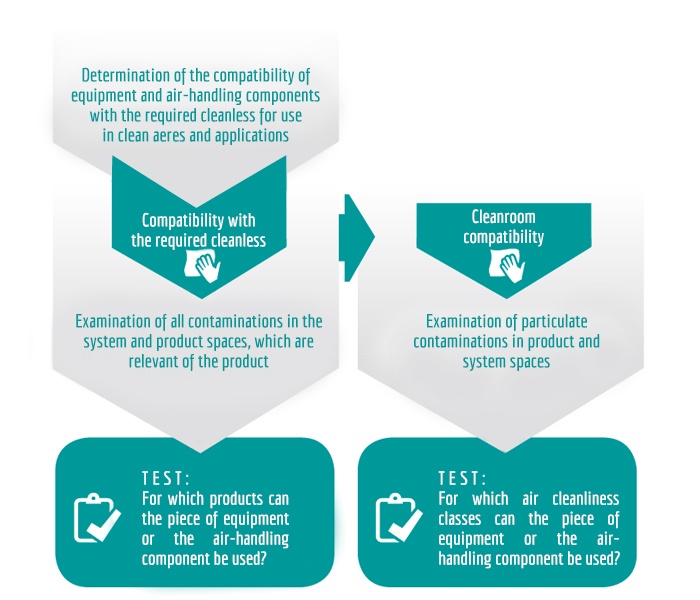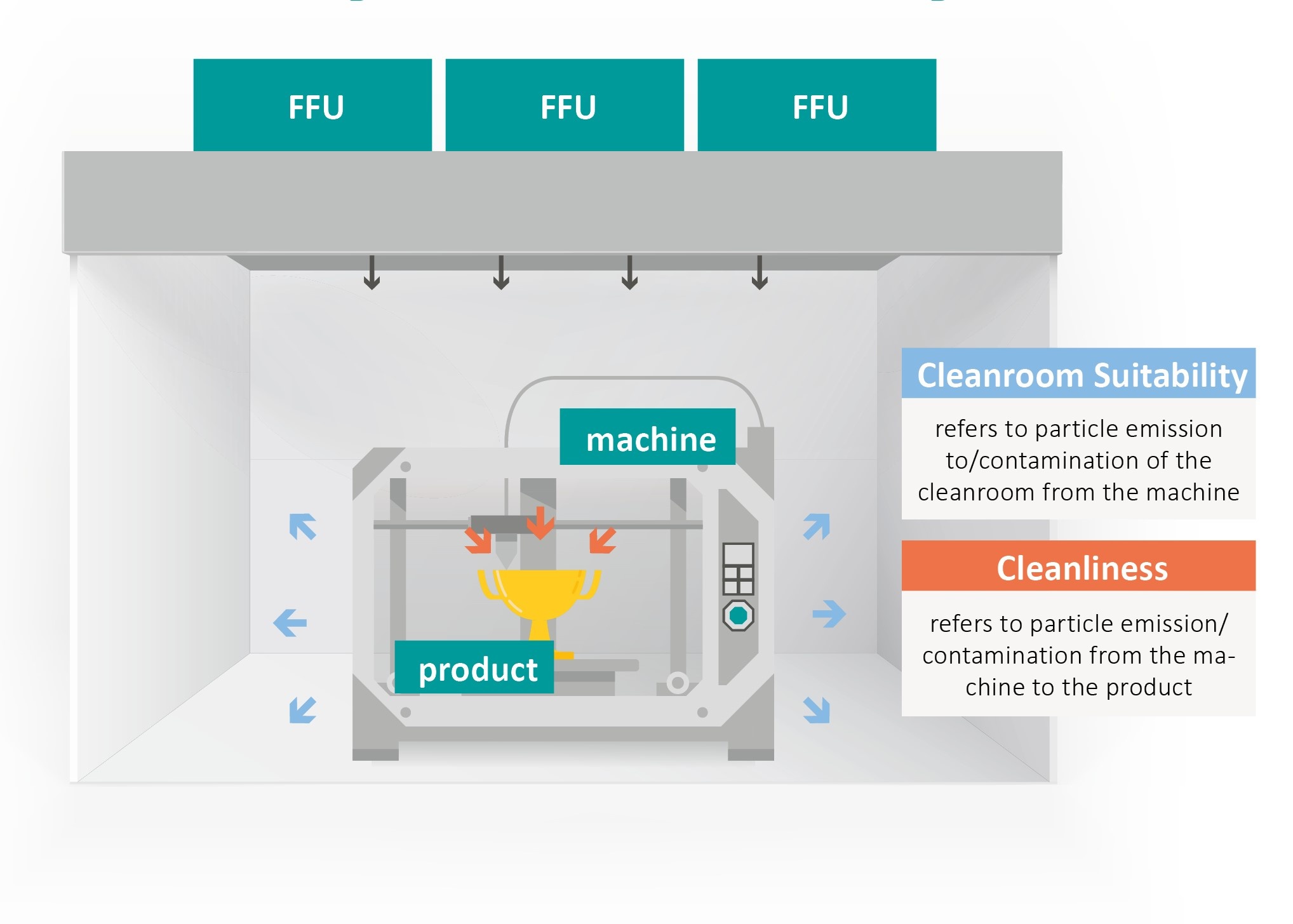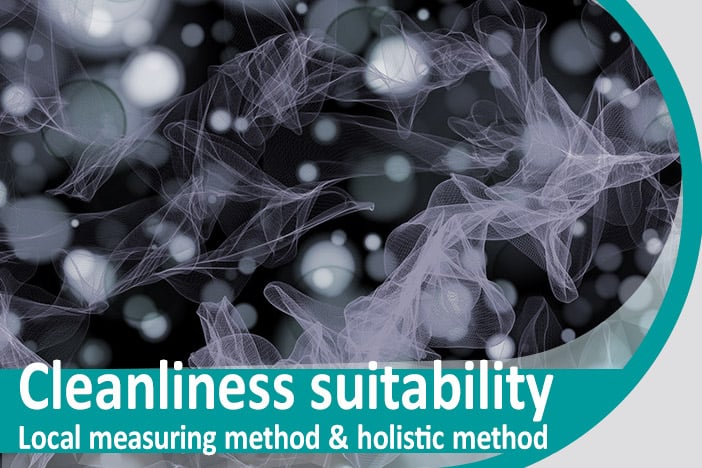Some industries must work under “clean” conditions, because even dust particle or outgassing can make a complete product batch unusable. What does cleanliness suitability exactly mean? How is it measured and how can it be determined? Would production under “pure” conditions also be a decisive competitive factor for your company? We will answer these questions for you in this blog article.
What is cleanliness suitability?
What exactly is meant by the term „cleanliness suitability“? The cleanliness suitability is regulated in the VDI guideline VDI 2083, sheet 9.1 “cleanroom technology – compatibility with required cleanliness and surface cleanliness” and is defined as follows:
“ Compatibility with the required cleanliness serves to assess pieces of equipment or air-handling components in view of their use in cleanrooms. It describes the generation or existence of the contamination generated by, or existing on, the piece of equipment or air-handling component.“ - VDI-guideline VDI 2083, sheet 9.1chapter 3.1.3
However, a universal definition set in stone does not justice to this multifaceted topic. The best way to illustrate the purity is in contrast to another requirement, namely the cleanroom suitability.
The cleanroom suitability describes the emission of contaminations of an operating material to the surrounding cleanroom. The cleanliness suitability is the particle delivery to the product being processed in the machine. The following graphic explains the procedure for determining the respective suitability: 
Source: VDI 2083 Sheet 9.1 Page 7 Picture 3

Cleanroom suitability is part of cleanliness suitability and not really important for the actual process itself. Cleanroom suitability is only important if you want to know how many machines are allowed to work in a cleanroom, without affecting the classification and if cross-contamination must be prevented.
Local measuring method
Holistic method
The VDI guideline is doubtlessly a good approach that promises commitment and reliable informative value. However, there is a limit: Unfortunately, the holistic method as a measurement method is only mentioned in passing.
A description of the total particulate emission per unit time is possible by using the holistic method. However, this method is not used for direct classification, which is no longer classifying in classes. That means, on the result sheet we read particles per second and not ISO 1, 2, 3 and so on.
If the holistic method can’t provide a classification of components in certain cleanliness classes, what benefit does it have?
Operating material can be compared with absolute accuracy using the holistic method. Whether it’s a laptop, a car or a production line – all components tell you how many particles per second they give off in their entireness.
How are the measurements made with the holistic method? The measured object is flushed with pure air and in the exhaust air, the particle concentration is measured as in the local method. In Addition, the volume flow of this exhaust air is determined. If the particle concentration in particles per cubic meter is multiplied by the volume flow in cubic meters per second, a particulate flow in particles per second is obtained.

The importance of cleanliness suitability
The cleanliness suitability is fundamental to all those, who use machines or components in a clean manufacturing environment.
Based on the example of the automotive industry, it becomes clear how important a clean production environment is in the diverse work steps: from paint and lighting to headlamps and diffusers to complete interiors – cleanroom technology plays an important role everywhere in the production process.
The main impulses for the application of cleanliness measures are:
- Prevention of rejects
- Reduction of costs
- Protection of quality standards
- Warranty of functioning
- Preserve the competitiveness
Cleanliness suitability - a guarantee for high return of investment
Risk management, added value and return of investment are important keywords for each company. The more complex and multi-ingredient a process, the more important a detailed monitoring is, so that weak points or blockages can be detected and eliminated as early as possible or even eliminated in advance. So if you ensure quality assurance along the entire process chain, smooth production processes, little rejects and only short downtimes are guaranteed. If machines, materials and components are suitable for cleanliness, numerous obstacles to clean, constant production are eliminated from the outset.
This aspect bends to the above-mentioned competitiveness again. If a company decides to have its products tested for cleanliness, then an employee of the marketing team should be involved in the decision-making process.
Cleanliness suitability is a feature of quality, innovation and cost assurance. So positive results should not lie dormant in a drawer, but must be made known to customers and interested parties!
Ways, to ensure cleanliness suitability
Get the free whitepaper „Ways to ensure cleanliness suitability“ and learn more about cleanliness suitability and why you should look beyond the confines of a cleanroom.


